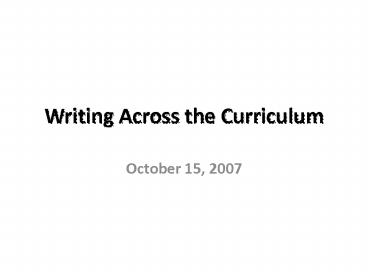Writing Across the Curriculum PowerPoint PPT Presentation
1 / 28
Title: Writing Across the Curriculum
1
Writing Across the Curriculum
- October 15, 2007
2
Goal
- Through the use of Writers Notebooks and
Accountable Talk, students and teachers will
learn how to ask questions, choose and develop
ideas worthy of study, sustain and focus
attention, and think more deeply and critically.
3
(No Transcript)
4
The Two Different Ways of WritingWriting to
Learn vs. Writing to Convey Learning (a.k.a.
Public Writing)
- Writing to Learn
- Writing to Convey
- Short
- Spontaneous
- Exploratory
- Informal
- Personal
- One draft
- Unedited
- Ungraded
- Substantial
- Planned
- Authoritative
- Conventional
- Audience centers
- Drafted
- Edited
- Assessable
5
Writing is considerably more than a way to record
and demonstrate knowledge. Writing is, most
importantly, a way of knowing, a way of working
through confusion and fuzzy ideas and moving
toward clarification and articulation of
knowledge. Writers literally achieve insight in
the act of writing new ideas come as we write
and from what we write. McLaughlin and Vogt
(2000)
6
Writers Notebook Is a Tool to
- Organize thoughts and information
- Reflect
- Refer to and be available for recall and later
use in reporting and discussion - Self-assess
- View their developmental progression through an
investigation, learning sequence, creation of a
project or product - Record ideas and questions for future study or
inquiry - Use a resource for the creation of a final
product or presentational writing - Develop a habit of mind in using writing as a
thinking tool
7
Writing to Think LearnWays to Use a Writers
Notebook
- Writing Break (a.k.a. Quick Write or Stop Jot)
- Brainstorming
- Drawing Illustrating
- Mapping
- Written Conversation (a.k.a. Dialogue Journaling)
- Write Around
- Double-Entry Journal
- K-W-L
- Reflective Writing
8
Accountable Talk FEEDS students learning and
writing
9
Using Writing to Learn and Accountable Talk to
Construct Understanding
- Practice by Doing
- Art movement investigation using Accountable Talk
and Notebook Writing
10
(No Transcript)
11
(No Transcript)
12
Mapping Strategy
- In your group, use either a Venn Diagram or H to
compare and contrast the two paintings. - Share
- Identify interesting similarities/differences and
try to name emerging categories
13
Brainstorming Strategy
- Individually, use brainstorming to address the
question - Given what weve observed and thought about the
similarities between these two paintings, what do
you think might be the underlying philosophy or
vision of art of this movement? - Underline or circle key words to share with your
group.
14
Definition of Art Movement
- Based on your group discussion, write a draft of
a statement that attempts to define this art
movement
15
surrealism (s?-re'?-liz'?m) n.
- An early 20th-century literary and artistic
movement that attempts to express the workings of
the subconscious and is characterized by
fantastic imagery and incongruous juxtaposition
of subject matter. - Literature or art produced in this style.
16
- surrealism (s?re'?liz?m) , literary and art
movement influenced by Freudianism and dedicated
to the expression of imagination as revealed in
dreams, free of the conscious control of reason
and free of convention. - The movement was founded (1924) in Paris by André
Breton, with his Manifeste du surréalisme, but
its ancestry is traced to the French poets
Baudelaire, Rimbaud, Apollinaire, and to the
Italian painter, Giorgio de Chirico. Many of its
adherents had belonged to the Dada movement . . .
- In art the movement became dominant in the 1920s
and 30s and was internationally practiced with
many and varied forms of expression. Salvador
Dalí and Yves Tanguy used dreamlike perception of
space and dream-inspired symbols such as melting
watches and huge metronomes.
17
- Max Ernst and René Magritte constructed fantastic
imagery from startling combinations of
incongruous elements of reality painted with
photographic attention to detail. These artists
have been labeled as verists because their
paintings involve transformations of the real
world. - Absolute surrealism depends upon images derived
from psychic automatism, the subconscious, or
spontaneous thought. Works by Joan Miró and André
Masson are in this vein. The movement survived
but was greatly diminished after World War II.
18
Reflective Writing
- Think about the process you just went through
- How did it feel?
- What was challenging?
- What was easy?
- What are the implications for student learning?
19
Looking at Student Work
- Student notebook entries
- across the curriculum
20
Use T-Chart to Identify
- What strategies are students using?
- What evidence of thinking do you notice?
21
(No Transcript)
22
(No Transcript)
23
TAXES
24
(No Transcript)
25
Thinking About Content Area Implications
- How have you used or
- how can you use these strategies in your content
area?
26
Matching Strategies to Texts
- Read Chew on This
- What kinds of big ideas or questions would you
want students to consider? - Which notebook strategies would be most
appropriate to use to help students think about
those big ideas?
27
Exploring Other Strategies from Content-Area
Writing
- Jigsaw sections of the book
- Drawing Illustrating
- Clustering
- Written conversation
- Carousel Brainstorming
- Read your section, present to rest of the group,
providing hands-on practice
28
Lesson Planning
- Looking at the curriculum map for next month,
what would be key places to bring in Writing to
Think/Learn strategies? - Develop a plan for introducing Writers Notebooks
- Identify which specific strategies you will use
- Assignment Bring samples of 2-5 student
notebooks with you to the next Professional
Development Day on November 30th.

